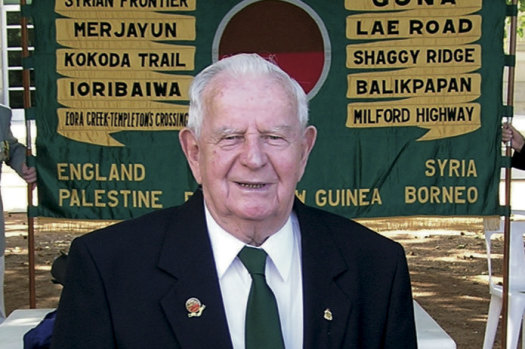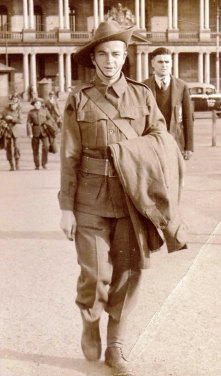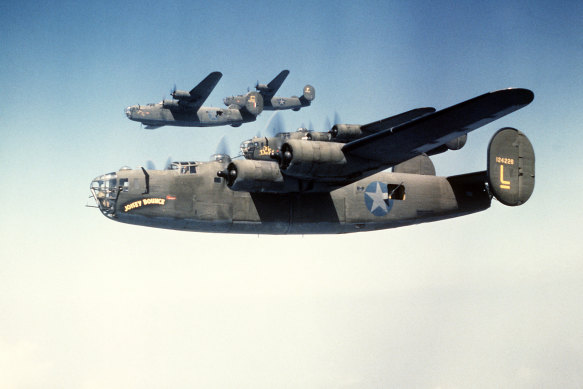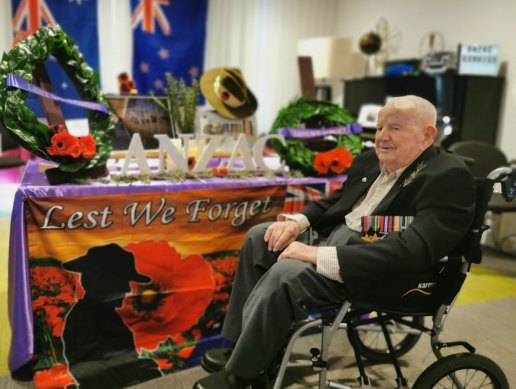Oldest survivor of World War II infantry battalion dies, aged 105
By Peter Allen
KENNETH WALTERS: 1919-2024
In common with so many others returning from war, one of Australia’s oldest World War II veterans, Kenneth “Smiler” Walters who has died in Sydney aged 105, never wanted to talk about the horror of battle.
A mortar man with the 2/33rd Australian Infantry Battalion, he fought in some of the fiercest actions to help defeat the Japanese in the Markham Valley, Lae, Shaggy Ridge and Balikpapan campaigns in New Guinea and Borneo in 1943 and 1945.
His gallantry in those campaigns has long been recorded but, until his death, he had an additional place in Australian military history as being among the last of the valiant few, but rapidly diminishing, living WWII veterans.

Ken Walters with the 2/33 Battalion banner.
Rightly proud of his part in helping save Australia from a brutal enemy, he was also the oldest of only three survivors of the 3065 men who saw action with the 2/33rd Battalion in World War II. The surviving members are aged 98 and 100.
Always cheerful throughout his life, Ken lived up to his nickname “Smiler”, gained after laughing at a mate’s joke during a lecture at Glenfield training camp in Sydney. The lieutenant giving the lecture said: “Right smiler, what were we talking about?” The nickname stuck.
A mortar man in the battalion’s 3rd Mortar Platoon, he had plenty of laughs about the mundane side of Army life in training and shared memories about the many mates he served with, some of whom became lifelong best friends. As a munitions handler, Walters carried great responsibility. He had to check highly dangerous mortar shells before firing, including double-checking for faulty fuses, which could cause “dropshots”, shells that fell short of their targets, sometimes on fellow troops.

Ken Walters in 1940.
One of his rare battle stories involved the time he almost certainly saved the lives of two of his mates, as well as his own – he detected a small crack in a shell they were about to fire. Had they done so the shell would have exploded in the barrel, potentially killing all three in the mortar pit, and probably others nearby. Most horrific among his memories was Australia’s worst air disaster, the crash at Port Moresby on September 7, 1943, of a fully armed US Army Air Force Liberator bomber into a convoy of trucks carrying men of the 2/33rd, including himself. The convoy was parked at the end of the runway awaiting orders to go to a nearby airstrip, to be airlifted over the Owen Stanley ranges and into battle to recapture Lae from the Japanese. The Liberator was attempting a pre-dawn take-off when a wing hit a tree, causing it to crash into the convoy. There were horrendous scenes when two of its 500-pound bombs and thousands of litres of aviation fuel exploded in a sea of fire. The crash claimed 60 lives, with another 90 injured.
Walters escaped injury but witnessed mates desperately trying to escape the inferno, their clothes on fire, and being blown up as their own grenades and ammunition exploded in the fierce heat. He helped to rescue injured mates.

A Liberator bomber similar to the one that crashed on take-off at Port Moresby in 1943.Credit: Internet
As with other crash survivors, the scenes haunted him for the rest of his life. “I could never forget them,” he once said with great emotion. He was always upset that after months of training preparing for the battle for Lae, so many were killed or injured before the fighting even started.
Walters was born in Sydney in June 1919 during the Spanish flu pandemic, a time of great distress, although greater hardship was to follow when the Great Depression gripped the world. He well remembered those tough times when he, his mother Amelia and older brother Harry had to keep moving looking for work. Finally, Amelia found regular employment at Griffith as a bush nurse.
His first job was at the Griffith store of Moran and Cato, at that time Australia’s largest chain of grocery stores. The family later returned to Sydney and lived at Fairlight. He had so impressed Moran and Cato managers with his diligence and dedication that he got a job back in Manly as soon as he was discharged at war’s end, working his way up to manager.
He had enlisted for Army service in January, 1940. Given the service number NX126043 he was called up for duty in June, 1942.
On leave in 1944, he met his wife-to-be at a Brisbane Army dance. Joan Muriel Meads was doing clerical duties and serving as a PT instructor and switchboard operator. They were married in 1946, the year of his discharge. They had two daughters, Kaye, born in 1947, and Debbie born in 1956.
After Moran and Cato, he worked as a tram conductor and bus driver, then at Qantas in Sydney in the stationery department until he retired.
He never lost touch with his wartime mates. A regular at 2/23 reunion dinners, he marched on Anzac Day, sometimes accompanied by his grandson Chris.
On retiring, Ken and Joan lived in the Anzac RSL Village in Narrabeen for 10 years from 2008, then moved into The Gracewood Community retirement village, Kellyville, so they could receive higher care and be nearer to Kaye, Debbie and their families. Ken and Joan had four grandchildren, 11 great grandchildren and three great-great grandchildren.
At Narrabeen and Gracewood Ken featured prominently in Anzac Day services, and celebrated his 105th birthday in style this year at Gracewood. After 75 years of marriage, Joan died in 2021.
Daughter Debbie, said: “In later years Ken’s short-term memory was failing but he still remembered his war years with mixed emotions. Like many of his mates, he suffered what we now call PTSD. War leaves scars both visible and invisible, but those times many years ago helped make him the wonderful father, person and lovable larrikin that he was.”

Lest We Forget - infantryman Ken Walters.
Ken is survived by Debbie, Kaye having predeceased him.